When you coming to Korea, chances are that you will be using public transportation like the subway, busses, taxis, or trains! If you are visiting Korea for the first time, it can be difficult to know how to use these forms of public transportation.
For all of you who are struggling to understand how to work the public transportation system in Korea, you have come to the right place! We will divei nto how to use the transportation card, transfer system and how to find your way around Korea via transport!
Transportation Card
Q1. Should I buy a transportation card when coming to Korea?
YES! With a public transportation card in Korea, you can use the subway and bus at a cheaper price than you could with cash. Also, when travelling in Seoul, there are a lot of subways and busses, so public transportation is many people's main form of transportation. It is a hassle to always have the correct amount of cash on you at all times, therefore using a transportation card is much easier. With a transportation card, you can also transfer from a subway to a bus or vice versa for no additional charge!
Getting a transportation card is very easy. They are sold in vending machines, at convenience stores, and even at Incheon International Airport! Don't forget to pick one up when you arrive!

Q2. Are there different types of transportation cards?
1) T-Money Card
There are many different types of transportation cards in Korea! the most common one is the T-money card (pictured above). This cart is the most popular, and the most commonly found card. It can be used on busses, subways, taxis, and express busses in Korea! It is a top up style card, where you can add money to the card and use it. One cool thing about this card is that it can be used like a debit card, not only can you use the money for transportation but it also works to buy stuff in convenience stores, some cafes, and certain fast food shops!

If you buy a T-money card that has a nationally compatible logo on it, you can also use it to purchase train tickets such as the KTX, and pay for highway tolls!

Source: T-Money Instagram
The price of the card itself (excluding public transportation charges) varies from 2,500 KRW to 13,000 KRW depending on the type of card you purchase. If you get a basic card, they are around 3,000 KRW. If you opt to buy a K-pop themed or cute character themed one the price will vary based on the design!

2) Cashbee Card
The Cashbee card is a transportation card that can be used almost similarly to the Tmoney card. It can be used on subways, busses, trains, and taxis! The Cashbee card can also be used at a variety of stores like the T-money card.
*There are some restrictions with the Cashbee card based on the city you are in. It cannot be used on busses in Geochang-gun and Hapcheon-gun in Gyeongnam.
 3) Discover Seoul Pass
3) Discover Seoul Pass
Tourists can opt to purchase a Seoul Pass, where you can enjoy free admission to 50 major tourist attractions inSeoul, as well as enjoy discounts on performances and shopping, as well as enjoy the T-money public transportation card function! You can learn more about it clicking the link below.
In addition to the transportation cards listed above, you can also get some other transportation cards such as CU Plus and Rail Plus. They are also used in the same way as the transportation cards listed above.
Q3. How do I purchase a transportation card?
Transportation cards can be found in many different places! You can purchase them at Incheon International Airport information desks, convenience stores and unmanned card vending machines in subway stations.
Once you choose the transportation card you want, you can tell the staff how much you would like to top up on the card. You can top up the card anywhere from 1,000 KRW to 90,000 KRW at a time. Make sure to bring enough cash, as these need to be topped up in cash!
Q4. Is the card fee refundable?
Unfortunately, you cannot refund your card after you purchase it. However, keeping the card is a fun souvenir of your trip!
Q5. Is there an expiration date for T-money?
No, there is no expiration date!
Q6. I have a lot of money left on my T-money card...can I get a refund?
Yes, you can get your money refunded (less that 20,000 KRW) at a convenience store (GS25, CU, 7/11, E-Mart 24. Mini Stop etc) If your remaining balance is above 20,000 KRW to 50,000 KRW you will have to get it refunded at the T-money service center in the metropolitan subway station. Keep in mind that the refund fee is 500 won!
Transfer System
Q1. How do I transfer on the public transportation in Korea?
| Public Transportation Transfer Policy | |
| Applicable Transport | Trains and busses nationwide |
| How to Transit | Tap your transportation card when getting on and off the transport *If you don't tap your card when getting off you may be subject to penalty fees |
Transit Times | Can be applicable within 30 minutes of getting off Applicable only when you have more than 250KRW credit on your transportation card *Does not work on same number bus, or same subway but different gate |
Earlybird Discount | If you ride the subway or bus between the time of the first ride ~ 6:30am you can receive a 20% discount (Partly implemented in Seoul, Gyeonggi-do, Busan) |
Korea's transportation system is very segmented, so you may have to transfer several times throughout to get to your destination.
The transfer discount system is a system where fares are charged based on the distance, rather than the types of transportation used. In other words, when using public transportation such as bus ↔ subway or subway ↔ bus or bus ↔ bus subway ↔ subway the fare will be the same and you will not get an additional charge.
However to get this discount, you must use the same transportation card, not a one time transportation card or cash. You also need to make sure to tap your transportation card when getting off the public transportation so that your transfer is taken into account.
Q2. Can I check the routes and traffic information through my phone?
All information regarding traffic conditions and route information is always connected online so it is easy to get very up-to-date information on the current status of your route through your phone.

By entering the departure point and your destination, you can find out the arrival time and your route. You can get almost all information about your route such as the arrival time of your bus or subway, and the times that the next bus or subway will come. You can get information about how crowded certain carriages are and about where to board for the best transfer as well!
Koreans usually use Naver Maps and Kakao Maps. If you use Kakao Maps and Naver Maps, you can find information about small shops and independent stores that may not be on Google Maps. You can also get specific information about the best routes to take and can compare the available routes. They are also available in English, Chinese, and Japanese as well so we recommend downloading these apps for your trip!
Subway
Q1. What are the prices for the subway?
*National basic rate
| Base Rate | Transportation Card | 1st Time Using Transportation Card |
| Regular | ₩ 1,250 | ₩ 1,350 |
| Teenager | ₩ 720 | ₩ 1,350 |
Children | ₩ 450 | ₩ 450 |
| Distance between start and end | Extra Charges |
| Within 10km | Does not exist |
| Between 10km-50km | ₩100 per 5km |
Over 50km | ₩100 per 8km |
When using Shin-Bundang Line | When using the Shin-Bundang Line there is an additional ₩700 |
*The extra charges vary by region. These are based on Seoul.
Korea's subway is the most used form of public transportation in Korea. It is much cheaper compared to the taxi and it never has traffic compared to driving, riding the bus, or taxi making it a reliable source of transportation.
The subway in the city is very cheap making it possible to be under 3,000KRW no matter how far the distance within the city.

There are a total of 17 lines that cross the city meaning you can comfortably go to anywhere in Seoul and cities close to it such as Incheon, Chuncheon, Suwon comfortably and at a cheap price. But the subways in Gyeonggido or Gangwondo don't have stations close to one another so you may have to ride the bus or the taxi to reach your final destination.
Q2. When are the first and last ride times for major subway stations in Korea?
1) Seoul
| Major Subway Station | First Train | Last Train |
| Seoul Station (Line1) | Weekdays: Soyosan Bound 05:48 /Seodongtan Direction 05:21 | Weekdays: Soyosan Bound: 23:04 / Seodongtan Bound 22:57 |
Saturdays: Soyosan Bound 05:54 / Seodongtan Bound 05:20 | Saturdays: Soyosan Bound 22: 55 / Seodongtan Bound 23:06 | |
Public Holidays: Soyosan Bound 05:54 / Seodongtan Bound 05:20 | Public Holidays: Soyosan Bound 22:55 / Seodongtan Bound 23:06 | |
| Yongsan Station (Line 1) | Weekdays: Uijeongbu Bound 07:41 | Weekdays: Uijeongbu Bound 23: 32 |
Saturdays: Uijeongbu Bound 07:40 | Saturdays: Uijeongbu Bound 23:24 | |
Public Holidays: Uijeongbu Bound 07:40 | Public Holidays: Uijeongbu Bound 23:24 | |
| Incheon International Airport (Airport Railway) | Weekdays: Seoul Station Bound 05:25 | Weekdays: Seoul Station Bound 23: 39 |
Saturdays: Seoul Station Bound 05:25 | Saturdays: Seoul Station Bound 23:39 | |
Public Holidays: Seoul Station Bound 05:25 | Public Holidays: Seoul Station Bound 23:39 | |
| Myeongdong Station (Line 4) | Weekdays: Danggogae Bound 06:03 / Oido Bound 05:45 | Weekdays: Hansung University Bound 23:48 / Seoul Station Bound 23:57 |
Saturdays: Danggogae Bound 05:37 / Oido Bound 05:47 | Saturdays: Hansung University Bound 23:51/ Seoul Station Bound 23:57 | |
Public Holidays: Danggogae Bound 05:37 / Oido Bound 05:47 | Public Holidays: Hansung University Bound 23:51 /Seoul Station Bound23:57 | |
| Gangnam Station (Line 2) | Weekdays: Seongsu Bound (Inner Line) 05:36 / Seongsu Bound (Outer Line) 05:44 | Weekdays: Seoul National University Bound 23:48 / Samsung Bound 24:52 |
Saturdays: Seongsu Bound (Inner Line) 05:35 / Seongsu Bound (Outer Line) 05:44 | Saturdays: Seoul National University Direction 24:48 /Samsung Direction 23:52 | |
Public Holidays: Seongsu Bound (Inside Line) 05:35 / Seongsu Direction(Outside Line) 05:44 | Public Holidays: Seoul National University Bound 23:45 / Samsung Bound 23:55 | |
| Sadang Station (Line 4) | Weekdays: Danggogae Bound 05:43 / Oido Bound 05:50 | Weekdays: Hansung University Direction 24:28 / Oido Bound 23:05 |
Saturdays: Danggogae Bound 05:56 / Oido Bound 05:50 | Saturdays: Hansung University Bound 23:31 / Sanbon Bound 24:00 | |
Public Holidays: Danggogae Bound 05:56 / Oido Bound 05:50 | Public Holidays: Hansung University Direction 23:31 / Sanbon Direction 24:00 | |
Hongdae Station (Line 2) | Weekdays: Seongsu Bound (Inner Line) 05:30 / Seongsu Bound (Outer Line) 05:30 | Weekdays: Euljiro Entrance Direction 24:49 / Sindorim Direction 24:51 |
Saturdays: Seongsu Direction(Inside Line) 05:30/ Seongsu Direction (Outside Line) 05:30 | Saturdays: Euljiro Entrance Direction 23:49 / Sindorim Direction 23: 51 | |
Public Holidays: Seongsu Bound (Inner Line) 05:30 Seongsu Direction (Outer Line) 05:30 | Public Holidays: Euljiro Entrance Bound 23:29 / Sindorim Bound 23:51 |
2) Busan
Major Subway Station | First Train | Last Train |
Airport (Busan Gimhae) | Sasang Bound 05:33 / Kaya University Bound 05:06 | Sasang Bound 24:10 / Kaya University Bound 23:48 |
Busan Station (Line 1) | Dadaepo Beach Bound 05:49 / Nopo Bound 05:26 | Dadaepo Beach Bound 23:56 / Nopo Bound 23:49 |
Nampo Station (Line 1) | Dadaepo Beach Bound 05:53 / Nopo Bound 05:23 | Dadaepo Beach Bound 24:00 / Nopo Bound 23:45 |
Seomyeon Station (Line 1) | Dadaepo Beach Bound 05:37 / Nopo Bound 05:37 | Dadaepo Beach Bound 23:44 / Nopo Bound 23:59 |
Haeundae Station (Line 2) | Jangsan Bound 06:09 / Yangsan Bound 06:39 | Jangsan Bound 24:32 / Yangsan Bound 23:14 |
Gwangalli Station (Line 2) | Jangsan Bound 05:56 / Yangsan 06:39 | Jangsan Bound 24:20 Yangsan Bound 23:26 |
3) Daegu
Major Subway Station | First Train | Last Train |
Ayanggyo Station (Line 1) | Seolhwa-Myeonggok Bound 05:35 / Ansim Bound 05:50 | Seolhwa-Myeonggok Bound 23:26 / Ansim Bound 23:43 |
Dongdaegu Station (Line 1) | Seolhwa- Myeonggok Bound 05:39 / Ansim Bound 05:46 | Seolhwa-Myeonggok Bound 23:29 / Ansim Bound 23:40 |
Daegu Station (Line 1) | Seolhwa-Myeonggok Bound 05:44 / Ansim Bound 05:41 | Seolhwa-Myeonggok Bound 23:35 / Ansim Bound 23: 42 |
Kyungpook National Univ. Hosp. (Line 2) | Munyang Bound 05:40 / Yeongnam Univ. Bound 05:46 | Munyang BOund 23:31 / Yeongnam Univ. Bound 23:25 |
Most subways start between 5:10-5:40 and end around 12:00. On the weekends, they tend to start about one hour later and end at 12:00. If you are out after 12:00 AM you may need to plan accordingly of how you will travel back to your accommodation or home.
It is also important to note that many last trains do not go all the way to the end of the line but stop at a terminal station that may not be all the way at the end of the line. Keep this in mind and make sure to plan accordingly.
On apps like Kakao and Naver Maps, you will be able to see the correct way to travel back or if there are alternative ways back to your destination.


Q4. How do I get a single use subway ticket?
Getting a single use subway ticket is very simple in Korea! You will need to go to the single use ticket / transportation card charging station which will be in the subway. There are English, Chinese, Japanese, and Korean options for the languages on the machine so do not worry about having a language barrier.
Select 'Sing-Use Transportation Card' and search for the station name that you want to go to.
If you press the route search button, you will be able to view the route map and select a station.
After selecting the destination, you can select the number of tickets that you want. Children are those between the ages of 6 and 13.
For single-use cards, you need to pay the fare+ a 500 KRW deposit. The deposit is refundable when you return the single-use card.

Q4. How do I get my 500 KRW deposit back?
There are deposit refund machines near the transportation card issuing machines. You can get a refund of 500 KRW by inserting your card here.

Q5. How do I transfer on the subway?
Transferring on the subway can be intimidating, but there is no need to worry! The subway system in Korea is organized very well and transferring is simple.
Once you get off the subway, look around and try to follow the arrows on the 'Transfer' sign. Do not follow the arrows on the 'Exit' sign!
Make sure to check the number and direction of the subway you want to transfer to. By following the arrows, you can get to the subway you want to ride. (The arrows are usually on a sign that corresponds to the color of the Line. Ex. Line 1 is dark blue and a transfer to Line 1 will be in a dark blue sign like picture above.)
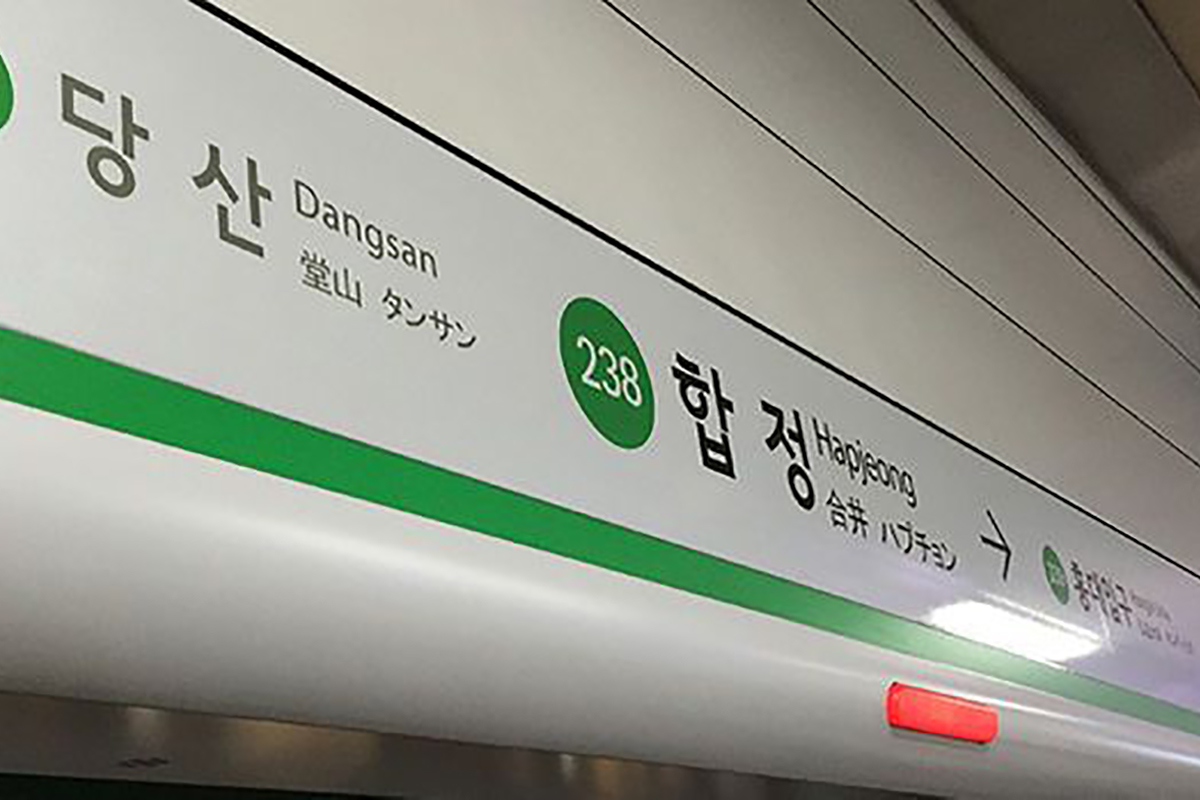
Q6. What do I do if I ride a subway heading in the opposite direction?
When riding the subway, you may get confused as to which direction is the right way. You might be worried about getting charged again. However there is no charge for riding in the opposite direction within the same station within 5 minutes. (This does not apply for single use or disposable transporation cards)
However if you are in another station and have already left the station you will have to go to the ticket gate in the direction you need to board and press the button on the ticket gate. Just let the staff know what happened and that you got off at the wrong direction, and the staff will assist you and help you get back in the correct direction.
Q7. Can I eat on the subway?
There are no legal restrictions regarding eating and drinking on subways. Therefore, pre-covid times, you might come acorss people munching on sweets, snacks or drinking coffee on the subway. However, eating smelly foods or messy foods like noodles, soups, and rice is not considered polite. There are no legal restrictions, but people tend to avoid smelly foods.
* Currently due to COVID-19, eating and drinking on subways are prohibited.
Buses
Q1. Why are all the busses different colors?
*Based on Seoul
| Color | Types of Busses |
| Red | Area Bus This means buses that go between Seoul and cities nearby directly. 4 digit numbers |
| Blue | City Bus that goes between far areas within Seoul. 3 digit numbers |
| Green | Intercity Bus that provides transport between subway stations and city buses. 4 digit numbers |
| Yellow | Short distance buses for intercity transport. 2 digit numbers |
*There are slight differences in the color and shape of busses across the country. However, nationwide, green or blue busses are the most common city buses.
Although subways can take you near your destination, your destination is not always within a 5 minute walk from the station. At these times, you can transfer to the bus and go to your destination for a cheap price. If you are moving within Seoul you will most likely be using the Blue, and Green buses.
Q2. How are the bus fares per bus?
Basic Fare Nationwide
City Bus Fare (Card) | City Bus Fare (Cash) | |
Seoul | ₩1,200 | ₩1,300 |
Busan | ₩1,200 | ₩1,300 |
Daegu | ₩1,250 | ₩1,400 |
Incheon | ₩1,250 | ₩1,270 |
*Rates are based on the most common green or blue city buses.
Seoul Bus Fare and Timetable
| Type | Transportation Card Fare | Cash Fare | First Bus | Last Bus | |
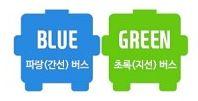 Blue, Green Blue, Green | Regular | ₩1,200 | ₩1,300 | 03:50-5:30 | 21:00-24:00 |
| Teenager | ₩720 | ₩1,000 | |||
| Children | ₩450 | ₩450 | |||
 Yellow Yellow | Regular | ₩1,100 | ₩1,200 | 06:30 | 22:00-23:00 |
| Teenager | ₩560 | ₩800 | |||
| Children | ₩350 | ₩350 | |||
 Red Red | Regular | ₩2,300 | ₩2,400 | 04:30-05:35 | 22:30-24:00 |
| Teenager | ₩1,360 | ₩1,800 | |||
| Children | ₩1200 | ₩1,200 | |||
The rates above are based on Seoul. Rates tend to vary by region. You will be charged accordingly based on the region and type of bus used.

The first bus and last bus as well as the price for the bus all are very different depending on the type of bus. The correct way to check for the correct routes and times is to check Naver Maps and search for a bus number. Unlike the subway, there are many changes that may occur to the bus schedule depending on various factors like traffic,. Make sure to plan your trip accordingly and to leave plenty of time for your travels!

Q4. How do board the bus?
When your bus arrived at your stop, board via the front door. The back door is for passengers getting off the bus. When you board the bus you will see a place where you can scan your transportation card. Scan it there or put your cash in the machine to pay by cash and board the bus! We recommend getting a transportation card as some busses do not take cash!

Q4. What do I if I want to get off the bus?
If you hear the station you want to get off please click the STOP bell. If you don't press the bell the bus driver may just pass the station.

Also don't forget to tap your transportation card when you exit. The transfer is only possible when you tap your transportation card and if you don't there is an extra fee that may be charged.

Q5. Can you eat food inside the bus?
You are not allowed to eat or drink on a city bus in Korea. Drinks and food that can be spilled on the bus are also restricted on the bus.
Not Allowed | Allowed |
| -Hot drinks or ice in a disposable cup -Chicken or Tteokbokki in a disposable cup -Various food in a disposable cup -Cans or drinks without a cap or a straw | -Chicken or pizza that is properly packaged in a box -A drink in a plastic cup that has a lid -A can that has not been opened -A closed tumbler, or water bottle -Vegetables or food ingredients in a bag |
Although you are allowed to bring foods on the bus, please remember you cannot drink or eat the food on the bus.
Q6. Can you tell me more about the airport bus?
Currently the airport bus is not operating due to the COVID-19 situation. We will update you with more detailed information as soon as the airport bus is running again!
Airport Bus Main Routes
Bus Number | Destination | Price | Intervals |
6001 | 15,000 KRW | 15-25 Minutes | |
6002 | 10,000 KRW | 10-20 Minutes | |
6006 | Jamsil, Apgujeong, Samseong-Dong COEX | 15,000 KRW | 15-30 Minutes |
Taxi
Q1. Are taxi fares in Korea expensive?
| Seoul Taxi Fare | Basic Fare | Additional Fare |
| During the day 04:00~24:00 | 3,800KRW | 100KRW per 132m |
| Late Night Premium 00:00~04:00 | 4,560 KRW (Seoul: 4,600 KRW) | 120KRW per 132m |
The taxi fares can't be said to be expensive but because the public transportation is well developed, it gives a feeling that it is relatively expensive.
Especially during peak hours or in the downtown area, you may arrive later than when you use public transport even though you pay much more.

You can also calculate the estimated Taxi fare when using Naver maps. An example is shown in the photo above showing the estimated taxi fare to be around 8,200 KRW. (this is an estimate only and may vary depending on the traffic conditions.)
Q2. What types of Taxi are available in Korea?
| Type | Information |
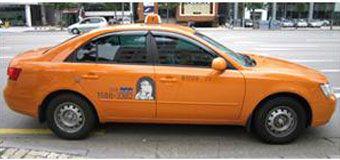 Regular Taxi Regular Taxi | The regular taxi has the cheapest fare and can be seen regularly around Seoul. The majority of them are orange but there are white and grey regular taxis. |
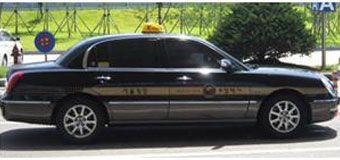 Model Taxi Model Taxi | The Model Taxi is more expensive than the regular taxi but they do not have the late night premium fee and the cars are relatively more luxurious. You can relax more and enjoy the ride. |
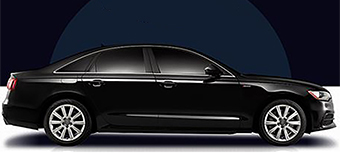 Luxury Taxi Luxury Taxi | This is a higher-level taxi than the standard taxi. They can be found via Kakao Black, Uber Black, Limo Black, Tada Plus and Tada Next. The price for them vary by each type. |
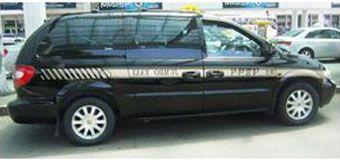 Large Taxi Large Taxi | The large taxi can fit up to 8 people and the fare is the same as the Model Taxi. |
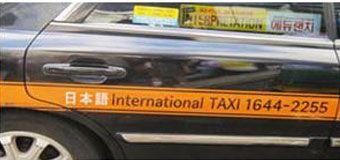 International Taxi International Taxi | The International Taxi's driver can speak foreign languages as shown on the side of the taxi such as English, Chinese, Japanese and more. The Taxi is black and orange and is a little bit more expensive than the regular taxi. |
Q14. Precautions when using the taxi
Taxi drivers often do not speak foreign languages well,. It will be helpful to the driver if you tell them the address in Korean or show them a map that is in Korean.
After boarding, make sure that the meter is running so you do not get ripped off.
Check Naver Maps as you are on the taxi to make sure that you are going the right way.
Denying a ride, or charging a higher fare is illegal, so check the license plate or driver information posted on the front of the vehicle.
Korean taxi license plate numbers contain 아 (ah), 바 (ba), 사 (sa) or 자 (ja) and are always colored in yellow. Make sure to always check this before getting on!
How to Get From Airport to Major Tourist Areas (Subway/ Bus)
Q1. How do I get to Seoul City Center from Incheon and Gimpo Airport via the subway?
The Airport Railroad is a convenient route that connect Incheon Airport, Gimpo Airport, and Seoul Station. You can also get off at Hongdae, which is a plus for many tourists!
1) Incheon & Gimpo Airport → Hongik University Station
Incheon & Gimpo Airport → Hongik University Station: Board the subway heading towards Incheon International Airport Cargo Terminal (Seoul Station Bound)
Hongik University Station → Incheon & Gimpo International Airport: Board the subway heading Digital Media City Station (Incheon Airport Terminal 2 Bound)
AREX | Incheon Airport Terminal 1 | Incheon Airport Terminal 2 | Gimpo Airport |
Price | 4,050 KRW | 4,650 KRW | 1,350 KRW |
Travel Time | About 51 minutes | Around 58 minutes | About 14 minutes |
*AREX: Airport Railroad Express
2) Incheon & Gimpo Airport (↔ Hongik University Station) ↔Jamsil station
Just like above, you should take AREX to Hongik University Station and transfer to Subway Line 2. You will travel around 20 stations (around 38 minutes) towards Sinchon Station on Line 2 (Seongsu Inner Line). Make sure to tae the train that is headed in the opposite direction of Gangnam Station!
AREX & Line 2 | Incheon Airport Terminal 1 | Incheon Airport 2 | Gimpo Airport |
Price (KRW) | 4,150 KRW | 4,750 KRW | 1,450 KRW |
Travel Time | Around 59 minutes | Around 66 minutes | Around 22 minutes |
3) Incheon & Gimpo Airport ↔ Seoul Station
Incheon & Gimpo Airport → Seoul Station: Towards Incheon International Airport Cargo Terminal Station (Seoul Station bound)
Seoul Station Incheon and Gimpo Airport Bound: Towards Gongdeok (Incheon International Airport Terminal 2 Bound)
AREX | Incheon Airport Terminal 1 | Incheon Airport Terminal 2 | Gimpo Airport |
Price (KRW) | 4,500 KRW | 5,350 KRW | 1,450 KRW |
Travel Time | Around 59 minutes | Around 66 minutes | Around 22 minutes |
4) Incheon & Gimpo Airport (↔Seoul Station) ↔ Myeongdong Station
To get to Myeongdong Station from the airport, you need to transfer at Seoul Station.
Like above, you will take the AREX to Seoul Station and transfer to Subway Line 4. You will travel for around 2 stations (3-5 minutes) towards Hoehyeon Station on Line 4 (Danggogae bound).
AREX | Incheon Airport Terminal 1 | Incheon Airport Terminal 2 | Gimpo Airport |
Price (KRW) | 4,150 KRW | 4,750 KRW | 1,450 KRW |
Travel Time | Around 71 minutes | Around 78 minutes | Around 34 minutes |
6) Incheon Airport ↔ Gimpo Airport
Incheon Airport Gimpo Airport: Incheon International Airport Cargo Terminal Station (Seoul Station Bound)
Gimpo Airport Incheon Airport: Heading towards Gyeyang Station (Incheon International Airport Terminal 2 Bound)
AREX | Incheon Airport Terminal 1 | Incheon Airport Terminal 2 |
Price | 3,750 KRW | 4,350 KRW |
Travel Time | Around 37 minutes | Around 44 minutes |
7) AREX
AREX direct trains only stop at Incheon Airport Terminal 1 and 2 and Seoul Station, making it very quick and easy to get from the airport to Seoul. Additionally if you book with Creatrip you can get it at a much lower price.
Price | 9,500 KRW (Same for both terminals 1 and 2) - 7,500 KRW for those that book through Creatrip! |
Travel Time | Terminal 1 - Seoul Station: 43 minutes / Terminal 2 - Seoul Station: 51 minutes |
8) Airport Bus
Currently the airport bus is not operating due to the COVID-19 situation. We will update you with more detailed information as soon as the airport bus runs again!
Bus Number | Headed Towards | Bus Price | Time Intervals |
6001 | 15,000 KRW | 15-25 Minutes | |
6002 | Hongik University, Sinchon Station | 10,000 KRW | 10-20 Minutes |
6006 | Jamsil, Apgujeong, Samseong-dong COEX | 15,000 KRW | 15-30 Minutes |
Q2. How to I get to Busan city center from Gimhae International Airport?
We recommend using the subway from Gimhae International Aiport to Busan's major tourist spots!
Airport → Major Areas (Seomyeon, Haeundae, Gwangalli): Busan Gimhae Light Rail Transit heading towards Seobusan area (Sasang Bound) → Transfer to Sasang Station →Board at Gamjeon Station (Jangsan bound)
Major Areas (Seomyeon, Haeundae, Gwangalli) → Airport: Line 2 (Yangsan Bound) → Transfer to Sasang Station → Busan Gimhae Light Rail (Kaya Univ. Bound)
Main Area (Line 2) | Price | Travel Time |
Seomyeon Station | 1,800 KRW | Around 36 minutes |
Haeundae | 2,000 KRW | Around 68 minutes |
Gwangalli | 2,000 KRW | Around 54 minutes |
Q3. How do I get to Daegu City Center from Daegu International Airport (or vice versa)?
Since there is no subway station nearby, it is convenient to go by bus! When returning to Daegu International Airport from central area, you can take the same bus and go in the opposite direction!
Main Area | Bus Number | Price | Travel Time |
Dongseongno (In front of Daegu Station) | 401 | 1,250 KRW | Around 33 minutes |
Dongdaegu Station Gyeongbu Line (Dongdaegu Station 1) | 401 | 1,250 KRW | Around 18 minutes |
How to Get From Seoul to Other Regions
When traveling from Seoul to other areas in Korea, it can get tricky knowing what types of transport to use to get around the country.
There are two main ways to get around conveniently in Korea, the train and the express busses.

Q1. How do I reserve a train ticket?
The fastest and most convenient way to travel from Seoul to other areas is via train. In Korea is the KTX, SRT, Saemaeul, and Mugunghwa trains.
The KTX is the fastest and most expensive train, and gradually get cheaper and slower in the following order SRT, Saemaeul, Mugunghwa. The KTX is about 2 times faster than the Mugunghwa trains.
Train ticket prices vary by speed and distance so you should always make sure to check beforehand!
1) Things to Keep In Mind When Reserving a Train Ticket
You can buy a ticket in person as well as online. However, as the interval between trains tend to be large depending on the region, reservations tend to fill up quickly, especially on holidays. If you have a travel schedule, it may be better to make a reservation in advance. Reservations can be made from one month to 20 minutes before the train departs. If the card is leaving 20 minutes you will have to buy the ticket on site.

2) Reserve on the Website
You can reserve on LetsKorail on Google. You can change the language from Korean to English, Chinese and Japanese by clicking on the language button in the upper right hand corner. On this website, you will be able to reserve and buy your ticket. However, if you reserve via the website, you may need to print your ticket at home after making your payment and reservation.
3) Reserve on the App
You can make a reservation easily by downloading the KORAIL Talk App and setting the language to your desired language (English, Chinese, Japanese). With this app you do not have to print out your ticket, you will get a online ticket in the app!
4) Reserve on Creatrip Website
You can easily make a KTX reservation through Creatrip! You can reserve tickets for major cities such as Seoul, Busan, Daegu, Gangneung, and Jeonju!
Q2. How do I use the express bus?

The express bus is a great option when trying to go to certain villages that are not reachable by trains. Intercity busses stop in the middle, but express busses do not have any stops, which means you can get to your destination quickly. It is convenient to take an express bus that goes straight to your desired destination right? You can buy express bus tickets at the station, website, or app. However, you will need a Korean phone number if you want to reserve beforehand. For those that do not have a Korean phone number, we suggest purchasing at the station!

You can reserve on the express bus website and set the website into the desired language out of the following languages: English, Chinese, Japanese, and Korean. Ticket reservations can be made on the website up to one hour before departure of the bus. If you decide to print out your ticket, you will not need to issue a separate ticket at the ticket counter. However, if you do not print it out, you will need to get it issued at the station before departure. To do so, you will need the credit card that you used to reserve the ticket.
Reserve on Website and Express Bus Information
Bicycle

The last form of public transport that we want to introduce is Seoul's public bicycle. You will most likely be able to find these bikes around areas like parks and rivers! Recently, Seoul has made it possible to rent a bike without identification or membership registration so that tourists can also use them!
1) Rent through the Mobile App
To rent the bikes via the mobile app, you will need to download the Seoul Public Bike app and make sure that you turn on both location and bluetooth functions on the app.

When you open the app you will see the following selection window. If you do not have some form of Korean identification then you will select 'Foreigner'. After selecting your nationalyty, you can sleect 'Buy Pass' on the green button at the bottom of the page.

You will then choose which type of pass you would like to purchase. (1 hour is 1,000 KRW, 2 hours is 2,000 KRW and a day pass is 5,000 KRW). You can then choose your credit card, enter your email address, and agree to the terms and conditions. Finally, you will pay!
2) Taking Your Bike

After purchasing a bike pass, you can open the app and press the 'Rent' button. Then scan the QR code under the bike seat with your mobile phone. Your lock will click and remove, allowing you to take the bike!
3) Returning Your Bike
Returning the bike is also very easy. You can place the bike at the bike stop at your desired location. You should try to lower the sliding lock under the seat on the rear wheel of the bicycle. (The app will display a message that the bike is locked)
If you want to unlock it again, you should press the "Temporarily Unlock" button.
You can learn more about Seoul's Public Bike system below!
We hope that this blog post cleared up any confusions you might have had with Korea's public transportation system! If you have any additional questions or concerns, please leave a comment below or send us an email at help@creatrip.com! Also make sure to follow us on Instagram, Tik Tok, and Facebook to stay updated on all things Korea!

